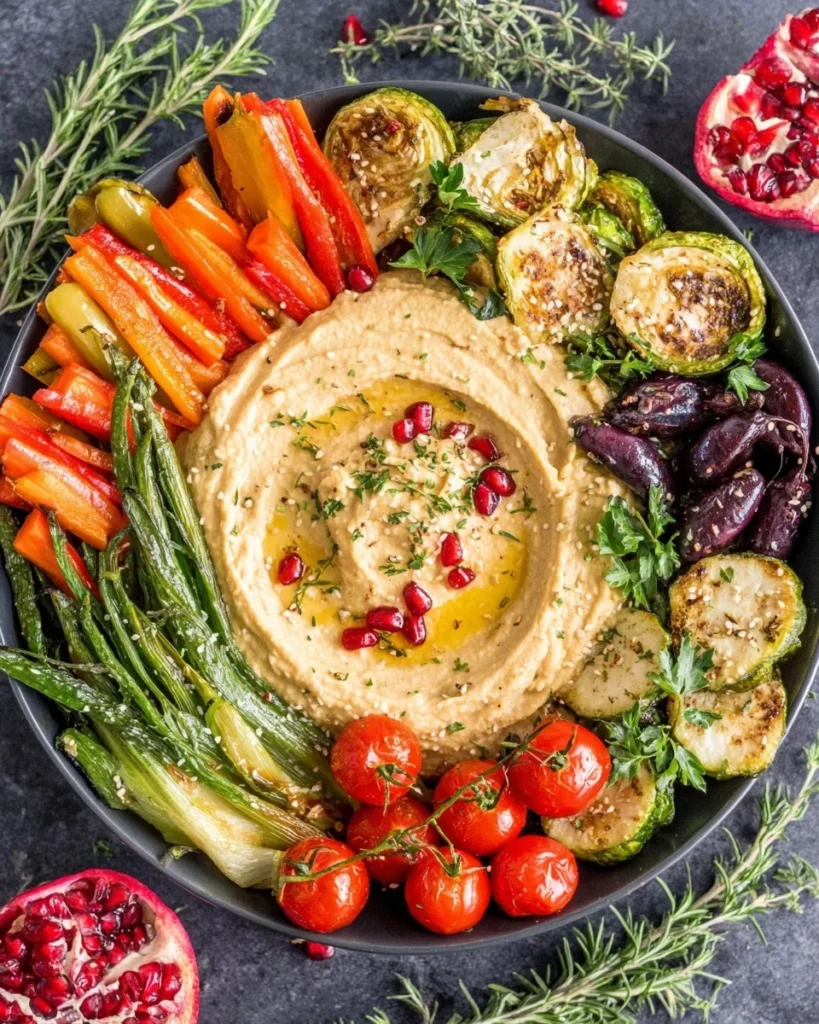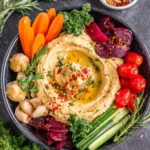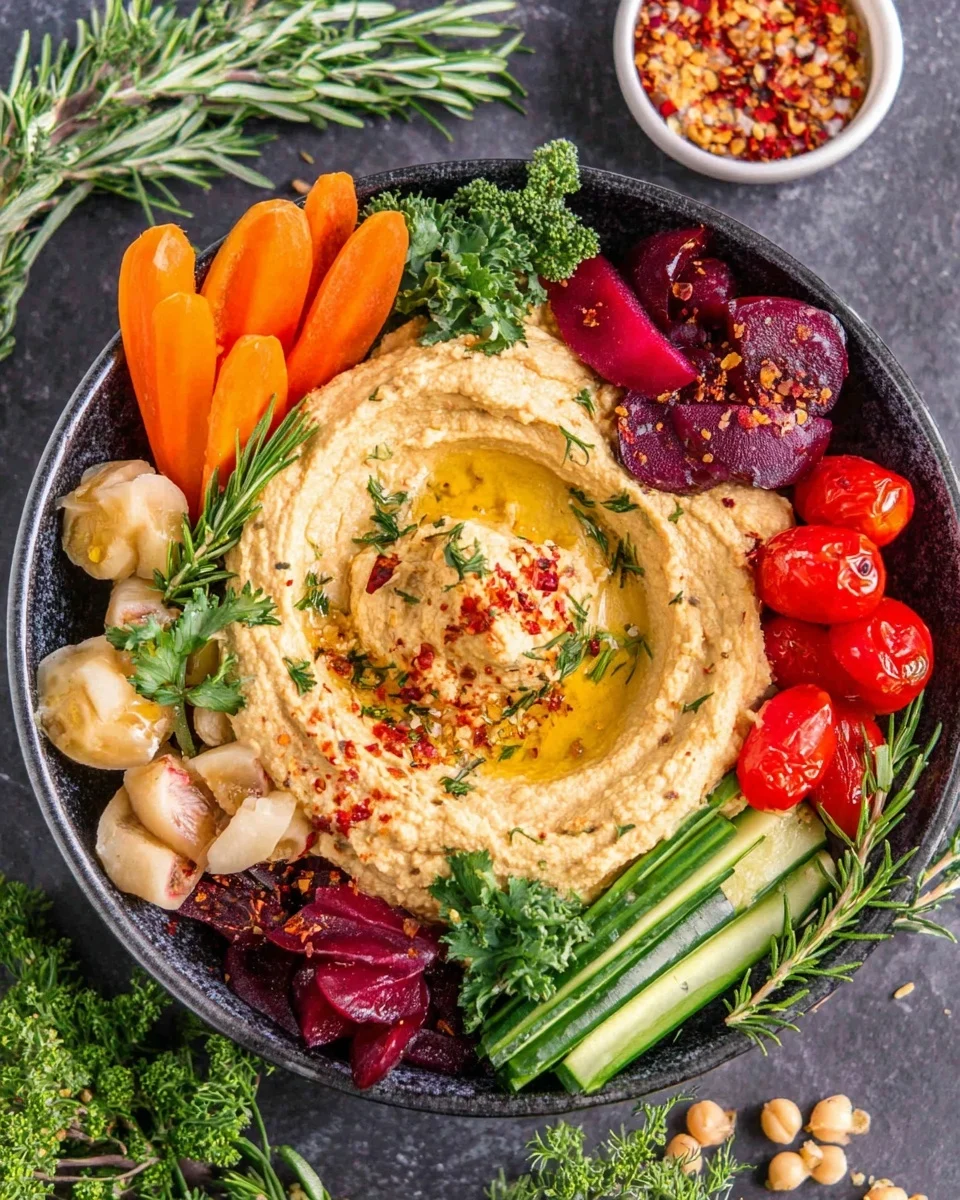There’s something beautifully simple — yet deeply satisfying — about the classic pairing of hummus and vegetables. Whether you’re gearing up for a day of clean eating, planning a party platter, or just looking for something nutritious to munch on between meals, hummus with fresh-cut vegetables is a snack that checks every box.
Creamy, savory, protein-rich hummus meets the crisp crunch of colorful vegetables in a combination that’s as nutritious as it is delicious. And the best part? You can whip this snack together in just a few minutes — no cooking required.
In this comprehensive guide, you’ll learn why hummus and vegetables make the ultimate healthy snack, how to make your own hummus from scratch, the best veggies for dipping, exciting variations, meal prep tips, storage hacks, serving ideas, health benefits, and answers to your most pressing questions.
Let’s dive in and discover why hummus and vegetables deserve a permanent spot in your weekly routine.
Why Hummus and Vegetables Make the Perfect Snack
Let’s start by answering the obvious question: Why is this combo so good?
1. Packed with Plant-Based Protein and Fiber
Hummus is made from chickpeas — a legume rich in plant-based protein and dietary fiber. Combined with fiber-packed vegetables like carrots, celery, and cucumbers, you get a snack that’s not only filling but also supports digestive health and stable blood sugar levels.
2. Quick and Easy to Prepare
If you’re constantly on the go, there’s nothing better than a healthy snack you can assemble in 10 minutes or less. Chop up some veggies, scoop some hummus (store-bought or homemade), and you’re done.
3. Naturally Gluten-Free and Vegan
This is one of the few snacks that fits almost every diet. Whether you’re vegan, gluten-intolerant, dairy-free, or simply trying to eat more plants, hummus and vegetables are a safe and inclusive choice.
4. Great for Meal Prep or Entertaining
From lunchboxes to party trays, this snack is totally adaptable. Pack it in containers for weekday munching or arrange it beautifully for a crowd — either way, it delivers on taste and nutrition.
5. Completely Customizable
You’re not stuck with just one flavor. From roasted red pepper hummus to spicy garlic versions — or even beetroot and avocado twists — you can mix and match hummus flavors with a wide variety of fresh-cut vegetables.
Homemade Hummus Recipe (Or Use Store-Bought)
If you’ve never made hummus from scratch, now’s the time to try. It’s creamy, rich, and so much better than the pre-packaged stuff. But don’t worry — if you’re short on time, store-bought hummus is absolutely fine.
Ingredients for Homemade Hummus:
- 1 can (15 oz) chickpeas, drained and rinsed
- ¼ cup tahini
- 2 tablespoons olive oil
- 1–2 cloves garlic
- Juice of 1 lemon
- ¼ teaspoon ground cumin
- Salt, to taste
- 2–4 tablespoons cold water (for creaminess)

How to Make It:
- Blend It All Up:
In a food processor, combine chickpeas, tahini, olive oil, garlic, lemon juice, cumin, and salt. Blend until mostly smooth. - Adjust Texture:
Add cold water, 1 tablespoon at a time, blending until the hummus is creamy and luscious. Taste and adjust seasoning as needed. - Serve or Store:
Transfer to a bowl for dipping, or portion into small containers for on-the-go snacking.
Best Vegetables to Serve with Hummus
One of the best things about hummus and vegetables is the incredible variety of dippers you can use. Choose a rainbow of veggies for the most appealing and nutritious spread.
Top Veggies for Dipping:
- Carrot sticks – sweet, crunchy, and colorful
- Celery sticks – crisp and hydrating
- Bell pepper strips – red, yellow, green, and orange for variety
- Cucumber spears – cooling and juicy
- Cherry tomatoes – a burst of sweetness
- Snap peas – naturally sweet and super satisfying
- Broccoli or cauliflower florets – great for a crunchy texture contrast
- Radishes – peppery and vibrant
- Zucchini sticks – mild and soft
- Jicama slices – crispy and refreshing
Mix and match to your heart’s content. You don’t need every single one — just two or three veggie options are enough for a delicious and balanced plate.
Hummus and Vegetables for Every Occasion
This combo isn’t just a snack — it’s a multi-purpose solution for every time of day and every type of eater.
1. Lunchbox Staple
Pack a small container of hummus with a handful of pre-cut veggies. It’s a nutrient-dense addition to any lunchbox and holds up well without refrigeration for a few hours.
2. After-School Snack
Kids love to dip — and when paired with colorful veggies, hummus becomes a fun and wholesome alternative to processed snack foods.
3. Pre-Dinner Appetizer
Hosting friends? Serve hummus and veggies as a light starter to keep everyone satisfied until the main course arrives.
4. Midnight Munchies
Need something quick, filling, and guilt-free? Skip the chips — dip veggies in hummus and feel good about your late-night snack.
Healthy Benefits of Hummus and Vegetables
It’s no exaggeration — this combo is a nutritional powerhouse. Here’s why:
1. High in Fiber
Both hummus and raw veggies are rich in dietary fiber, which promotes better digestion, satiety, and even heart health.
2. Excellent Source of Plant-Based Protein
Especially important for vegetarians and vegans, hummus delivers about 5 grams of protein per serving — plus the added benefits of essential amino acids when paired with a variety of veggies.
3. Full of Antioxidants
Vegetables like bell peppers, cherry tomatoes, and broccoli are loaded with vitamins A, C, and K — all of which support your immune system and overall health.
4. Heart-Healthy Fats
Olive oil and tahini, both key components in hummus, are rich in monounsaturated fats, known for lowering bad cholesterol levels and reducing the risk of heart disease.
5. Low Glycemic Index
Hummus and vegetables help stabilize blood sugar, making this snack a safe and satisfying choice for diabetics or anyone watching their carb intake.
How to Store and Meal Prep
Make your life easier with smart prepping and storing techniques.
Meal Prep Tips:
- Portion hummus into small containers or jars
- Chop veggies ahead of time and store them in airtight containers with a damp paper towel to stay crisp
- Layer in jars for easy grab-and-go snacking
- Use bento boxes for a fun and organized lunch setup
Storage:
- Homemade hummus lasts up to 5 days in the fridge
- Pre-cut veggies should be eaten within 3–4 days for best texture and freshness
- Never store wet veggies submerged in water — it makes them soggy
Fun Flavor Variations
Bored of basic hummus? Mix it up with these delicious and creative ideas:
Hummus Flavors to Try:
- Roasted Red Pepper
- Garlic and Herb
- Cilantro Lime
- Spicy Chipotle
- Beetroot
- Avocado Hummus
- Sun-Dried Tomato
These can all be made at home or bought in stores — just make sure to check the ingredient list for clean, natural ingredients if going the pre-made route.
What to Serve with Hummus (Besides Veggies)
While hummus and vegetables is a match made in heaven, you can go beyond the basics if you want to add more variety.
Other Dippers to Consider:
- Whole grain pita bread or pita chips
- Seed crackers
- Rice cakes
- Pretzel sticks
- Grilled flatbread
- Sliced apples or pears (surprisingly tasty!)
Make It a Meal
Want to turn this into a light lunch or dinner? Add some extras to make it more filling:
- A handful of nuts or seeds
- A boiled egg on the side
- A few slices of roasted tofu
- A small serving of quinoa or couscous
- Add hummus to a wrap or sandwich with grilled veggies
FAQs About Hummus and Vegetables
Is hummus and vegetables a complete meal?
It can be! While it’s primarily a snack, you can turn it into a light meal by adding more protein or pairing it with whole grains or legumes.
How long does homemade hummus last?
Stored in an airtight container in the fridge, homemade hummus will last up to 5 days.
Can you freeze hummus?
Yes — hummus freezes well. Just leave a little space at the top of the container for expansion. Thaw overnight in the fridge and stir well before serving.
Which store-bought hummus brands are healthiest?
Look for brands with minimal ingredients — ideally just chickpeas, tahini, olive oil, lemon, and garlic. Avoid added sugars or preservatives.
Are raw vegetables better than cooked for dipping?
Raw veggies offer more crunch and retain more nutrients, especially vitamin C. That said, lightly steamed broccoli or cauliflower can also be delicious with hummus.
Can I eat hummus every day?
Absolutely — in moderation. Hummus is a nutrient-dense food and makes a great daily snack, especially if you vary the flavors and veggie pairings.
Conclusion
If you’re looking for a snack that’s as nutritious as it is delicious, it’s hard to beat the unbeatable pairing of hummus and vegetables. This classic combination delivers on every front: flavor, health, convenience, and versatility.
Whether you’re dipping crunchy carrots into garlic hummus after a workout, layering cucumber spears into a lunchbox, or setting out a vibrant veggie platter for your next party, one thing’s for sure — this is a snack that never gets old.
So go ahead, grab that can of chickpeas, slice up those bell peppers, and get dipping. Your body (and your taste buds) will thank you.
Print
Hummus and Vegetables: The Ultimate Healthy Snack
Ingredients
For the Hummus (or use store-bought):
-
1 can (15 oz) chickpeas, drained and rinsed
-
¼ cup tahini
-
2 tbsp olive oil
-
1–2 cloves garlic
-
Juice of 1 lemon
-
¼ tsp ground cumin
-
Salt, to taste
-
2–4 tbsp cold water (for creaminess)
For the Vegetables:
-
Carrot sticks
-
Celery sticks
-
Bell pepper strips (red, yellow, green)
-
Cucumber spears
-
Cherry tomatoes
-
Snap peas
-
Broccoli or cauliflower florets
-
Optional: sliced radishes, zucchini, or jicama
Instructions
1. Make the Hummus (5 minutes!)
-
Add chickpeas, tahini, olive oil, lemon juice, garlic, cumin, and salt to a food processor.
-
Blend until smooth, adding water a tablespoon at a time until creamy.
2. Prep the Veggies
-
Wash and slice your vegetables into dippable shapes.
-
Arrange on a platter or pack into containers for grab-and-go snacking.
3. Serve
-
Spoon hummus into a bowl or small jars.
-
Surround with colorful veggies — or layer them in a bento box or jar for a fun presentation.
